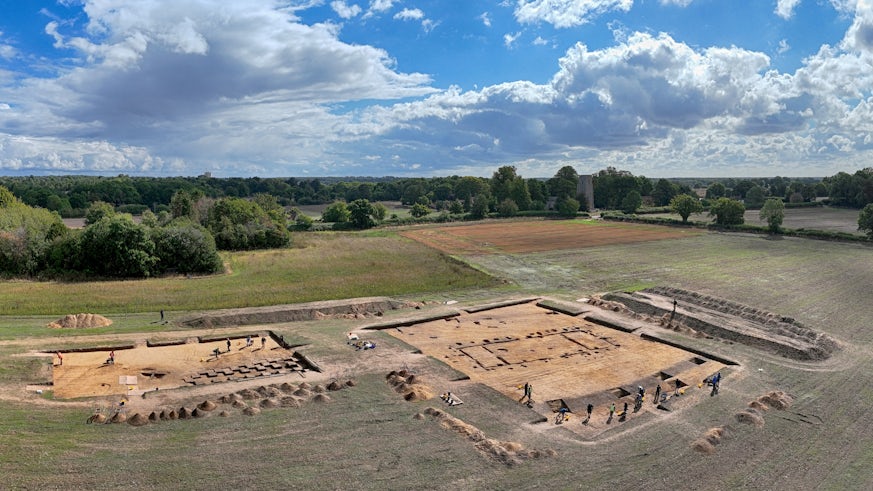Royal Hall of the East Anglian Kings discovered
13 October 2022

Evidence of the 1,400 year-old royal hall of the first Kings of East Anglia has been unearthed in the Rendlesham Revealed project.
The foundations of the large and elaborate timber hall were uncovered in a community archaeological excavation in Suffolk.
The discovery confirms that this site is the royal residence as recorded in the writings of the Venerable Bede in the 8th century.
The hall – at 23m long and 10m wide - is part of a 6-hectare royal compound within a 50-hectare settlement.
This was the centre from which a major province of the East Anglian kingdom – modern-day Suffolk and Norfolk - was ruled for 150 years, from 570AD to 720AD.
Bede’s writings identified Rendlesham as the place where the East Anglian King Aethelwold stood sponsor at the baptism of King Swithelm of the East Saxons.
Rendersham Revealed principal academic advisor Professor Christopher Scull, Honorary Visiting Professor at Cardiff University, said:
“The results of this season’s excavation are of international importance. Rendlesham is the most extensive and materially wealthy settlement of its date known in England, and excavation of the Hall confirms that this is the royal residence recorded by Bede.
“Only at Rendlesham do we have the wider settlement and landscape context of an early English royal centre together with an assemblage of metalwork that illuminates the lives and activities of its inhabitants across the social range. Together, these are radically re-writing our understanding of the sophistication, complexity and international connections of society at that time. This is a major advance in our understanding of the early East Anglian Kingdom and the wider North Sea world of which it was a part.”
The excavations revealed:
- the foundations of the large timber Hall, as first identified by aerial photography in 2015
- the perimeter ditch enclosing the royal compound
- the remains of food preparation and feasting indicating vast consumption of meat (mainly beef and pork)
- dress jewellery, personal items, fragments of glass drinking vessels and pottery
- traces of earlier settlement and activity on the site in the early Roman period (1st century AD) and back to the early Neolithic period (4th millennium BC)
The excavated building would have been one of several such monumental halls in the royal compound. Here, the first Kings of the East Angles would have travelled between this and other halls, administering justice, receiving tribute and diplomatic envoys, feasting with their followers, and distributing gifts and favours accompanied by their household and armed retinue.
In earlier years, archaeological investigations have recovered precious metalwork and coinage indicative of the wealth and status of those who stayed here. The nearby burial mounds at Snape and Sutton Hoo are two of the known Princely Burials associated with this royal settlement.
The discoveries came during the second summer of community excavations involving 250 local volunteers, including young adults from the Suffolk Family Carers and Suffolk Mind and over 100 local school children. Further fieldwork will take place next year.
Rendlesham Revealed: Anglo-Saxon Life in South-East Suffolk is run by the Suffolk County Council Archaeological Service, supported by Cotswold Archaeology and funded by The National Lottery Heritage Fund.